DAPC: Domain Adaptation People Counting Via Style-Level Transfer Learning and Scene-Aware Estimation
Na Jiang,
Xingsen Wen,
Zhiping Shi

Auto-TLDR; Domain Adaptation People counting via Style-Level Transfer Learning and Scene-Aware Estimation
Similar papers
VGG-Embedded Adaptive Layer-Normalized Crowd Counting Net with Scale-Shuffling Modules
Dewen Guo, Jie Feng, Bingfeng Zhou

Auto-TLDR; VadaLN: VGG-embedded Adaptive Layer Normalization for Crowd Counting
Abstract Slides Poster Similar
Spatial-Related and Scale-Aware Network for Crowd Counting
Lei Li, Yuan Dong, Hongliang Bai

Auto-TLDR; Spatial Attention for Crowd Counting
Abstract Slides Poster Similar
Encoder-Decoder Based Convolutional Neural Networks with Multi-Scale-Aware Modules for Crowd Counting
Pongpisit Thanasutives, Ken-Ichi Fukui, Masayuki Numao, Boonserm Kijsirikul

Auto-TLDR; M-SFANet and M-SegNet for Crowd Counting Using Multi-Scale Fusion Networks
Abstract Slides Poster Similar
Learning from Web Data: Improving Crowd Counting Via Semi-Supervised Learning
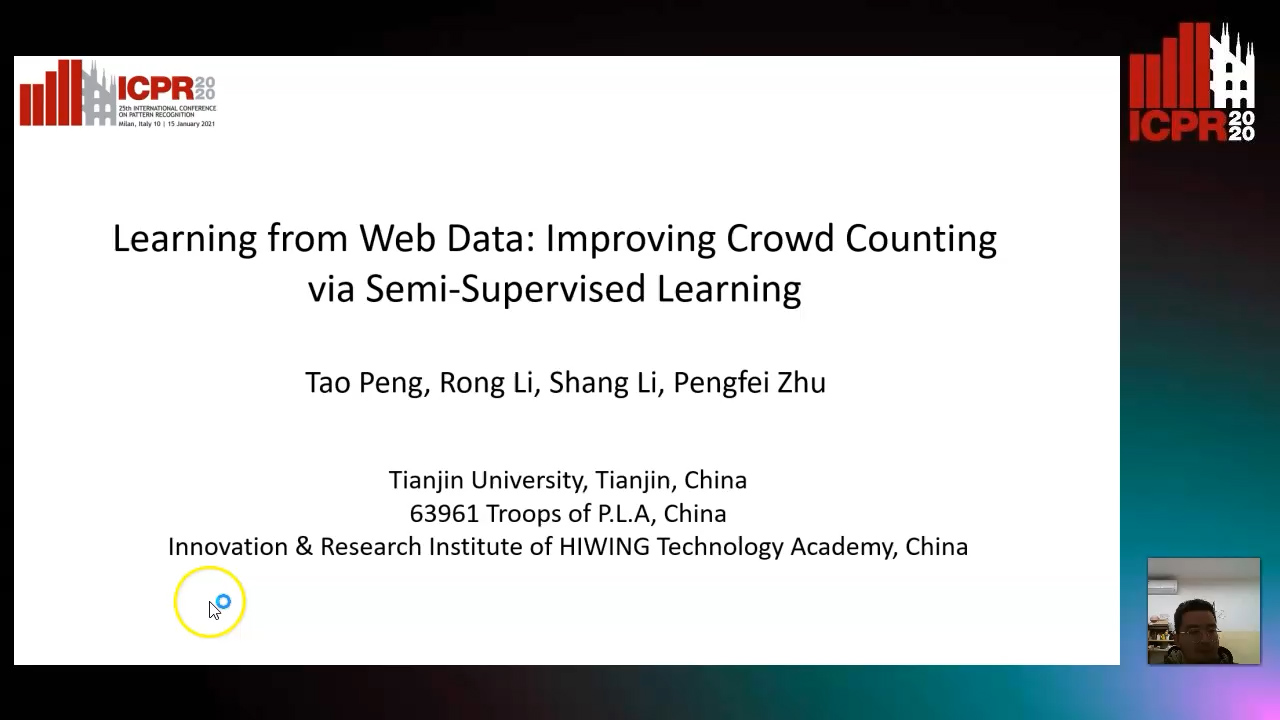
Auto-TLDR; Semi-supervised Crowd Counting Baseline for Deep Neural Networks
Abstract Slides Poster Similar
Learning Error-Driven Curriculum for Crowd Counting
Wenxi Li, Zhuoqun Cao, Qian Wang, Songjian Chen, Rui Feng
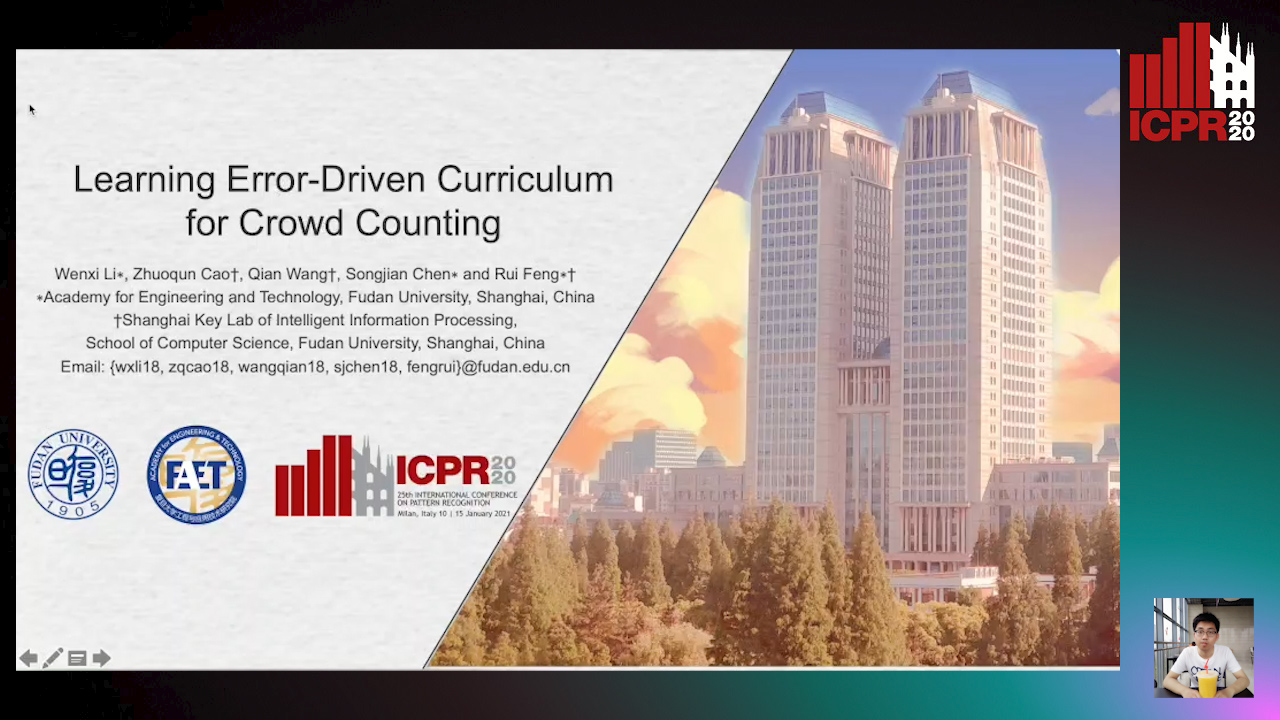
Auto-TLDR; Learning Error-Driven Curriculum for Crowd Counting with TutorNet
Cross-Domain Semantic Segmentation of Urban Scenes Via Multi-Level Feature Alignment
Bin Zhang, Shengjie Zhao, Rongqing Zhang
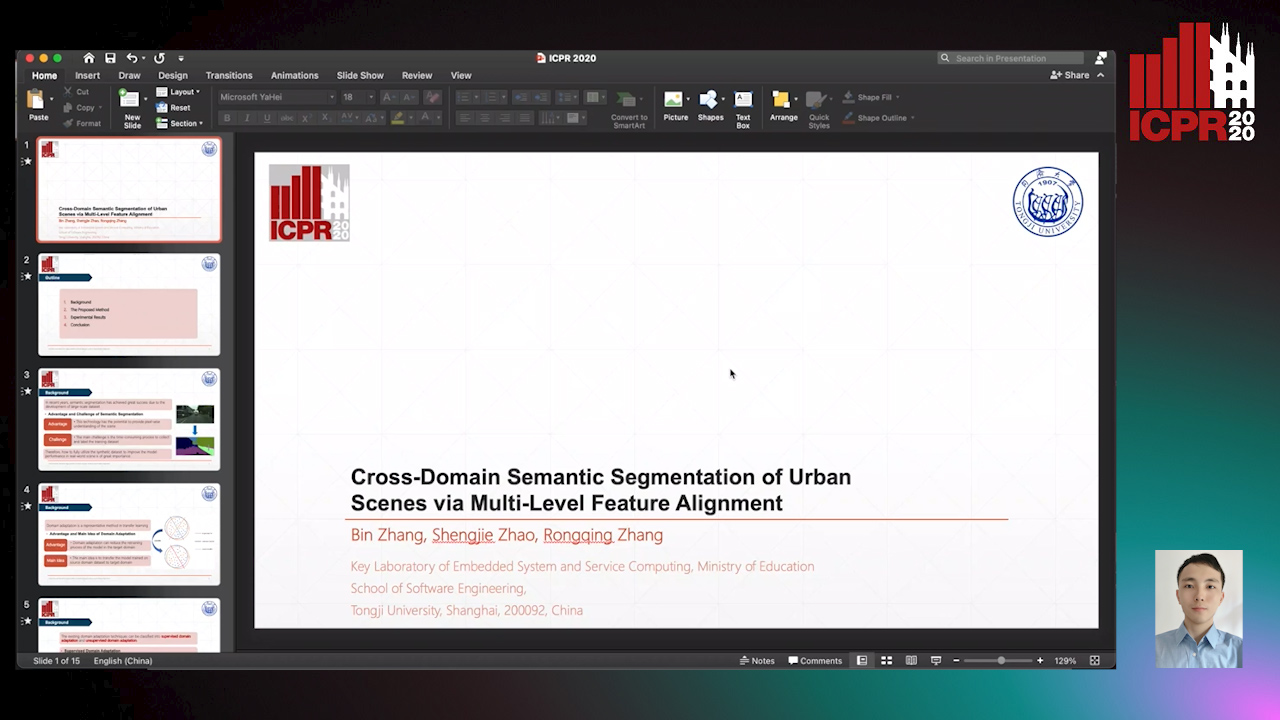
Auto-TLDR; Cross-Domain Semantic Segmentation Using Generative Adversarial Networks
Abstract Slides Poster Similar
Multi-Resolution Fusion and Multi-Scale Input Priors Based Crowd Counting
Usman Sajid, Wenchi Ma, Guanghui Wang
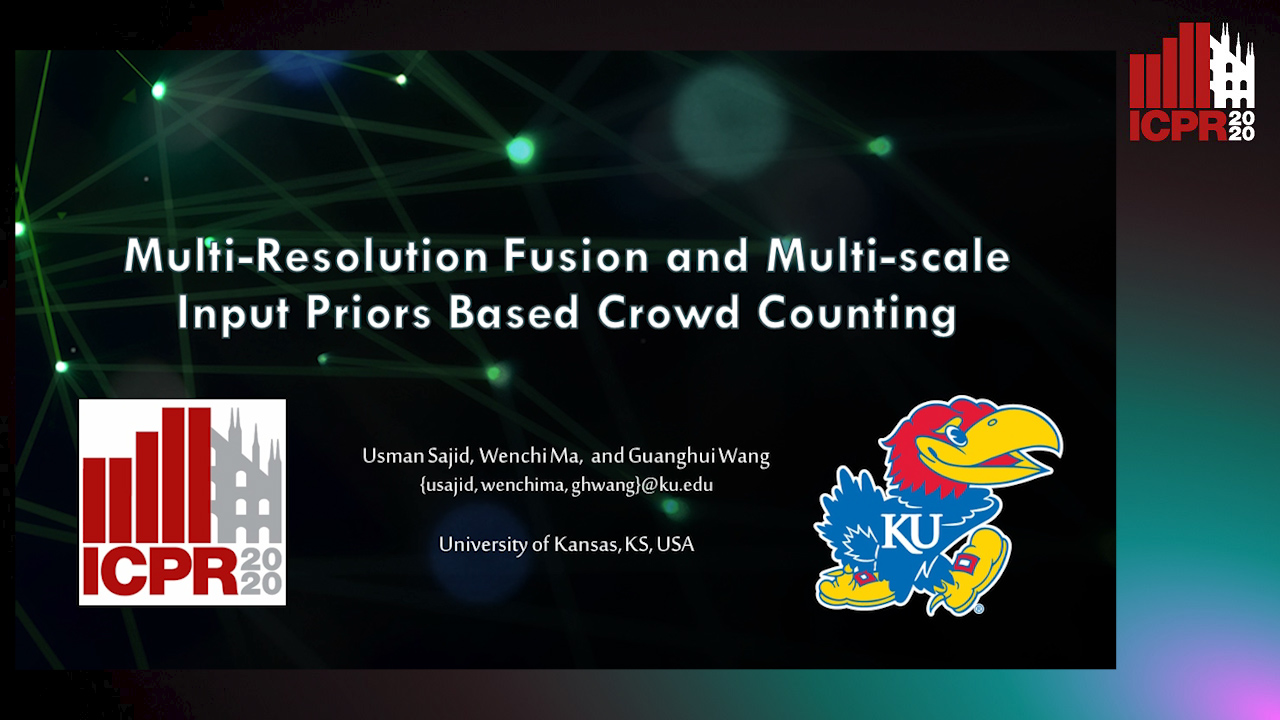
Auto-TLDR; Multi-resolution Fusion Based End-to-End Crowd Counting in Still Images
Abstract Slides Poster Similar
HANet: Hybrid Attention-Aware Network for Crowd Counting
Xinxing Su, Yuchen Yuan, Xiangbo Su, Zhikang Zou, Shilei Wen, Pan Zhou
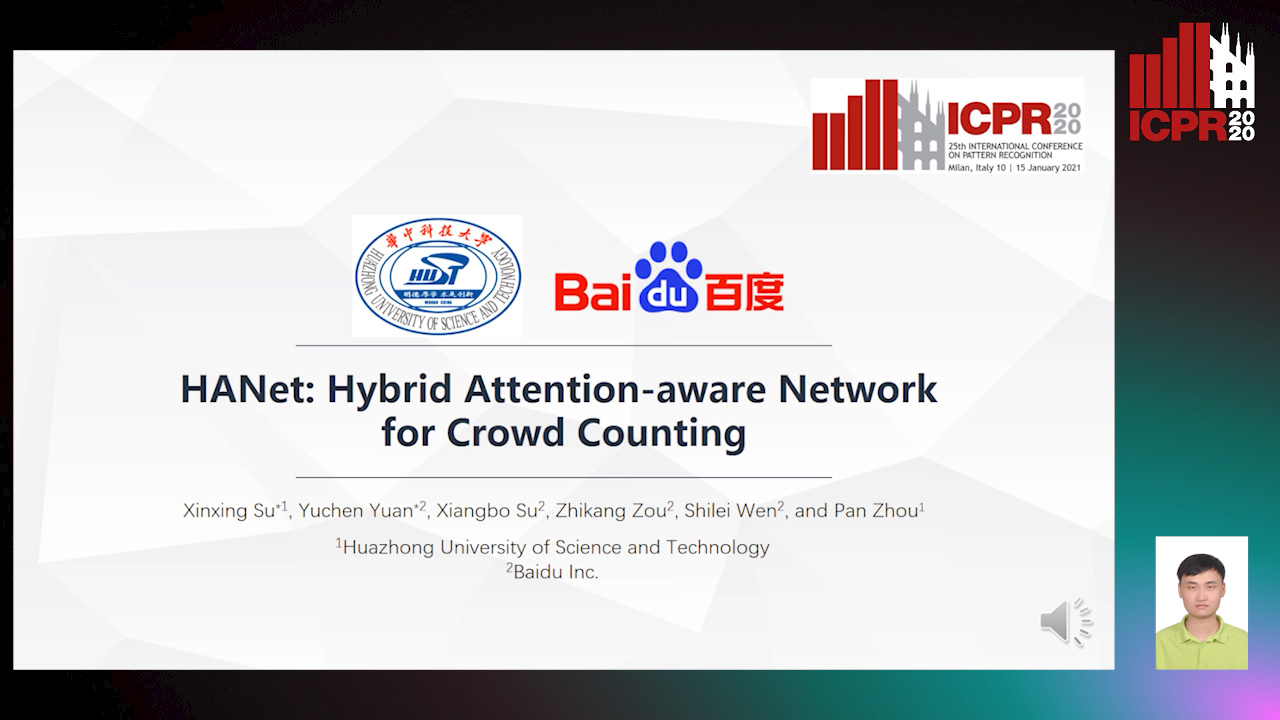
Auto-TLDR; HANet: Hybrid Attention-Aware Network for Crowd Counting with Adaptive Compensation Loss
PHNet: Parasite-Host Network for Video Crowd Counting
Shiqiao Meng, Jiajie Li, Weiwei Guo, Jinfeng Jiang, Lai Ye

Auto-TLDR; PHNet: A Parasite-Host Network for Video Crowd Counting
Abstract Slides Poster Similar
Detail Fusion GAN: High-Quality Translation for Unpaired Images with GAN-Based Data Augmentation
Ling Li, Yaochen Li, Chuan Wu, Hang Dong, Peilin Jiang, Fei Wang

Auto-TLDR; Data Augmentation with GAN-based Generative Adversarial Network
Abstract Slides Poster Similar
Unsupervised Multi-Task Domain Adaptation

Auto-TLDR; Unsupervised Domain Adaptation with Multi-task Learning for Image Recognition
Abstract Slides Poster Similar
Pose Variation Adaptation for Person Re-Identification
Lei Zhang, Na Jiang, Qishuai Diao, Yue Xu, Zhong Zhou, Wei Wu

Auto-TLDR; Pose Transfer Generative Adversarial Network for Person Re-identification
Abstract Slides Poster Similar
Spatial-Aware GAN for Unsupervised Person Re-Identification
Fangneng Zhan, Changgong Zhang

Auto-TLDR; Unsupervised Unsupervised Domain Adaptation for Person Re-Identification
Foreground-Focused Domain Adaption for Object Detection

Auto-TLDR; Unsupervised Domain Adaptation for Unsupervised Object Detection
Unsupervised Domain Adaptation with Multiple Domain Discriminators and Adaptive Self-Training
Teo Spadotto, Marco Toldo, Umberto Michieli, Pietro Zanuttigh

Auto-TLDR; Unsupervised Domain Adaptation for Semantic Segmentation of Urban Scenes
Abstract Slides Poster Similar
Shape Consistent 2D Keypoint Estimation under Domain Shift
Levi Vasconcelos, Massimiliano Mancini, Davide Boscaini, Barbara Caputo, Elisa Ricci

Auto-TLDR; Deep Adaptation for Keypoint Prediction under Domain Shift
Abstract Slides Poster Similar
Open Set Domain Recognition Via Attention-Based GCN and Semantic Matching Optimization
Xinxing He, Yuan Yuan, Zhiyu Jiang

Auto-TLDR; Attention-based GCN and Semantic Matching Optimization for Open Set Domain Recognition
Abstract Slides Poster Similar
Point In: Counting Trees with Weakly Supervised Segmentation Network
Pinmo Tong, Shuhui Bu, Pengcheng Han

Auto-TLDR; Weakly Tree counting using Deep Segmentation Network with Localization and Mask Prediction
Abstract Slides Poster Similar
A Unified Framework for Distance-Aware Domain Adaptation
Fei Wang, Youdong Ding, Huan Liang, Yuzhen Gao, Wenqi Che

Auto-TLDR; distance-aware domain adaptation
Abstract Slides Poster Similar
Efficient Shadow Detection and Removal Using Synthetic Data with Domain Adaptation
Rui Guo, Babajide Ayinde, Hao Sun

Auto-TLDR; Shadow Detection and Removal with Domain Adaptation and Synthetic Image Database
Unsupervised Domain Adaptation for Person Re-Identification through Source-Guided Pseudo-Labeling
Fabian Dubourvieux, Romaric Audigier, Angélique Loesch, Ainouz-Zemouche Samia, Stéphane Canu

Auto-TLDR; Pseudo-labeling for Unsupervised Domain Adaptation for Person Re-Identification
Abstract Slides Poster Similar
Text Recognition in Real Scenarios with a Few Labeled Samples
Jinghuang Lin, Cheng Zhanzhan, Fan Bai, Yi Niu, Shiliang Pu, Shuigeng Zhou

Auto-TLDR; Few-shot Adversarial Sequence Domain Adaptation for Scene Text Recognition
Abstract Slides Poster Similar
Manual-Label Free 3D Detection Via an Open-Source Simulator
Zhen Yang, Chi Zhang, Zhaoxiang Zhang, Huiming Guo

Auto-TLDR; DA-VoxelNet: A Novel Domain Adaptive VoxelNet for LIDAR-based 3D Object Detection
Abstract Slides Poster Similar
Domain Generalized Person Re-Identification Via Cross-Domain Episodic Learning
Ci-Siang Lin, Yuan Chia Cheng, Yu-Chiang Frank Wang

Auto-TLDR; Domain-Invariant Person Re-identification with Episodic Learning
Abstract Slides Poster Similar
Deep Reinforcement Learning for Autonomous Driving by Transferring Visual Features
Hongli Zhou, Guanwen Zhang, Wei Zhou
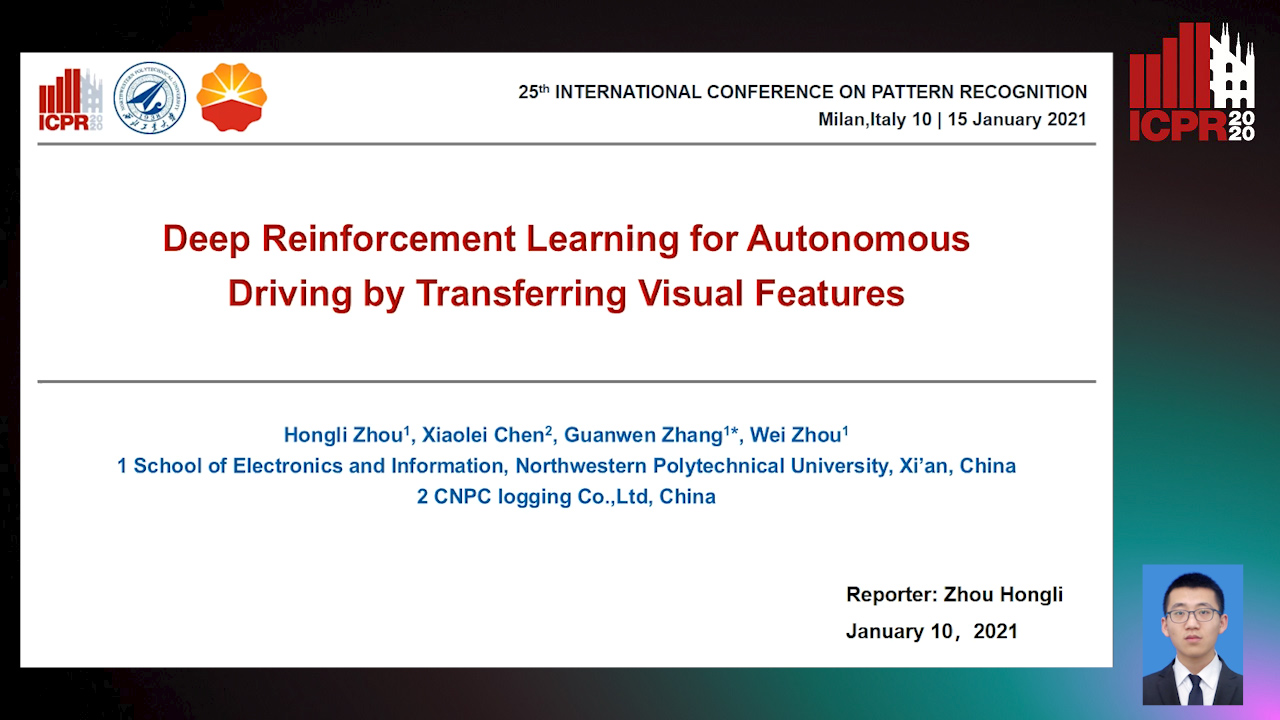
Auto-TLDR; Deep Reinforcement Learning for Autonomous Driving by Transferring Visual Features
Abstract Slides Poster Similar
Learning Low-Shot Generative Networks for Cross-Domain Data
Hsuan-Kai Kao, Cheng-Che Lee, Wei-Chen Chiu

Auto-TLDR; Learning Generators for Cross-Domain Data under Low-Shot Learning
Abstract Slides Poster Similar
Enlarging Discriminative Power by Adding an Extra Class in Unsupervised Domain Adaptation
Hai Tran, Sumyeong Ahn, Taeyoung Lee, Yung Yi

Auto-TLDR; Unsupervised Domain Adaptation using Artificial Classes
Abstract Slides Poster Similar
Local Facial Attribute Transfer through Inpainting
Ricard Durall, Franz-Josef Pfreundt, Janis Keuper

Auto-TLDR; Attribute Transfer Inpainting Generative Adversarial Network
Abstract Slides Poster Similar
RGB-Infrared Person Re-Identification Via Image Modality Conversion
Huangpeng Dai, Qing Xie, Yanchun Ma, Yongjian Liu, Shengwu Xiong

Auto-TLDR; CE2L: A Novel Network for Cross-Modality Re-identification with Feature Alignment
Abstract Slides Poster Similar
Learning Disentangled Representations for Identity Preserving Surveillance Face Camouflage
Jingzhi Li, Lutong Han, Hua Zhang, Xiaoguang Han, Jingguo Ge, Xiaochu Cao

Auto-TLDR; Individual Face Privacy under Surveillance Scenario with Multi-task Loss Function
Building Computationally Efficient and Well-Generalizing Person Re-Identification Models with Metric Learning
Vladislav Sovrasov, Dmitry Sidnev

Auto-TLDR; Cross-Domain Generalization in Person Re-identification using Omni-Scale Network
DEN: Disentangling and Exchanging Network for Depth Completion
You-Feng Wu, Vu-Hoang Tran, Ting-Wei Chang, Wei-Chen Chiu, Ching-Chun Huang

Auto-TLDR; Disentangling and Exchanging Network for Depth Completion
Cycle-Consistent Adversarial Networks and Fast Adaptive Bi-Dimensional Empirical Mode Decomposition for Style Transfer
Elissavet Batziou, Petros Alvanitopoulos, Konstantinos Ioannidis, Ioannis Patras, Stefanos Vrochidis, Ioannis Kompatsiaris

Auto-TLDR; FABEMD: Fast and Adaptive Bidimensional Empirical Mode Decomposition for Style Transfer on Images
Abstract Slides Poster Similar
Augmented Cyclic Consistency Regularization for Unpaired Image-To-Image Translation
Takehiko Ohkawa, Naoto Inoue, Hirokatsu Kataoka, Nakamasa Inoue

Auto-TLDR; Augmented Cyclic Consistency Regularization for Unpaired Image-to-Image Translation
Abstract Slides Poster Similar
GAP: Quantifying the Generative Adversarial Set and Class Feature Applicability of Deep Neural Networks
Edward Collier, Supratik Mukhopadhyay

Auto-TLDR; Approximating Adversarial Learning in Deep Neural Networks Using Set and Class Adversaries
Abstract Slides Poster Similar
Data Augmentation Via Mixed Class Interpolation Using Cycle-Consistent Generative Adversarial Networks Applied to Cross-Domain Imagery
Hiroshi Sasaki, Chris G. Willcocks, Toby Breckon

Auto-TLDR; C2GMA: A Generative Domain Transfer Model for Non-visible Domain Classification
Abstract Slides Poster Similar
A Simple Domain Shifting Network for Generating Low Quality Images
Guruprasad Hegde, Avinash Nittur Ramesh, Kanchana Vaishnavi Gandikota, Michael Möller, Roman Obermaisser

Auto-TLDR; Robotic Image Classification Using Quality degrading networks
Abstract Slides Poster Similar
Distortion-Adaptive Grape Bunch Counting for Omnidirectional Images
Ryota Akai, Yuzuko Utsumi, Yuka Miwa, Masakazu Iwamura, Koichi Kise

Auto-TLDR; Object Counting for Omnidirectional Images Using Stereographic Projection
Continuous Learning of Face Attribute Synthesis
Ning Xin, Shaohui Xu, Fangzhe Nan, Xiaoli Dong, Weijun Li, Yuanzhou Yao

Auto-TLDR; Continuous Learning for Face Attribute Synthesis
Abstract Slides Poster Similar
Rethinking Domain Generalization Baselines
Francesco Cappio Borlino, Antonio D'Innocente, Tatiana Tommasi

Auto-TLDR; Style Transfer Data Augmentation for Domain Generalization
Abstract Slides Poster Similar
Attention-Based Model with Attribute Classification for Cross-Domain Person Re-Identification
Simin Xu, Lingkun Luo, Shiqiang Hu

Auto-TLDR; An attention-based model with attribute classification for cross-domain person re-identification
Free-Form Image Inpainting Via Contrastive Attention Network
Xin Ma, Xiaoqiang Zhou, Huaibo Huang, Zhenhua Chai, Xiaolin Wei, Ran He

Auto-TLDR; Self-supervised Siamese inference for image inpainting
Teacher-Student Competition for Unsupervised Domain Adaptation
Ruixin Xiao, Zhilei Liu, Baoyuan Wu

Auto-TLDR; Unsupervised Domain Adaption with Teacher-Student Competition
Abstract Slides Poster Similar
Small Object Detection by Generative and Discriminative Learning
Yi Gu, Jie Li, Chentao Wu, Weijia Jia, Jianping Chen

Auto-TLDR; Generative and Discriminative Learning for Small Object Detection
Abstract Slides Poster Similar
Unsupervised Contrastive Photo-To-Caricature Translation Based on Auto-Distortion
Yuhe Ding, Xin Ma, Mandi Luo, Aihua Zheng, Ran He

Auto-TLDR; Unsupervised contrastive photo-to-caricature translation with style loss
Abstract Slides Poster Similar
Joint Supervised and Self-Supervised Learning for 3D Real World Challenges
Antonio Alliegro, Davide Boscaini, Tatiana Tommasi

Auto-TLDR; Self-supervision for 3D Shape Classification and Segmentation in Point Clouds
Adversarially Constrained Interpolation for Unsupervised Domain Adaptation
Mohamed Azzam, Aurele Tohokantche Gnanha, Hau-San Wong, Si Wu

Auto-TLDR; Unsupervised Domain Adaptation with Domain Mixup Strategy
Abstract Slides Poster Similar
Coarse to Fine: Progressive and Multi-Task Learning for Salient Object Detection
Dong-Goo Kang, Sangwoo Park, Joonki Paik

Auto-TLDR; Progressive and mutl-task learning scheme for salient object detection
Abstract Slides Poster Similar